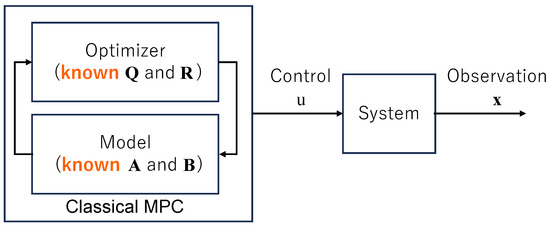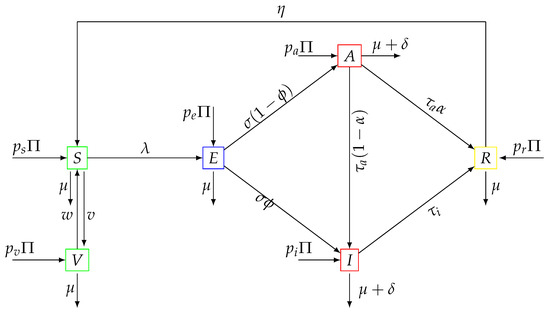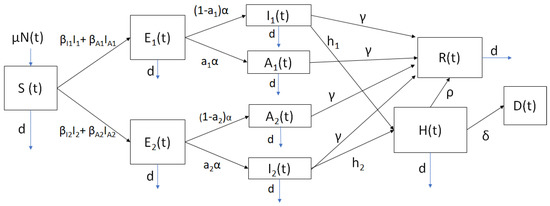Mathematical Modelling of COVID-19
Share This Topical Collection
Editor
 Dr. Cristiana João Soares da Silva
Dr. Cristiana João Soares da Silva
 Dr. Cristiana João Soares da Silva
Dr. Cristiana João Soares da Silva
E-Mail
Website
Collection Editor
1. Department of Mathematics, ISTA, Iscte—Instituto Universitário de Lisboa, Av. das Forças Armadas, 1649-026 Lisboa, Portugal2. Center for Research and Development in Mathematics and Applications (CIDMA), Department of Mathematics, University of Aveiro, 3810-193 Aveiro, Portugal
Interests: optimal control; calculus of variations; optimization; mathematical models for infectious diseases; application of optimal control to epidemiology; ordinary differential equations; stability; qualitative investigation and simulation of models
Special Issues, Collections and Topics in MDPI journals
Topical Collection Information
Dear Colleagues,
COVID-19 pandemic has been affecting our world for more than one year. Scientists from many different fields have been working hard, trying to use their skills and knowledge on the control and eradication of the pandemic. Mathematical models are one of the tools that has been used to model and predict the evolution of the pandemic under different scenarios.
This Collections aims to gather original scientific papers where different mathematical tools are used to study the transmission dynamics of SARS-CoV-2 and discuss control strategies of COVID-19 pandemic.
Topics of interest include, but are not limited to: mathematical modeling, optimization methods, complex networks, stochastic and hybrid models applied to COVID-19.
Dr. Cristiana J. Silva
Collection Editor
Manuscript Submission Information
Manuscripts should be submitted online at www.mdpi.com by registering and logging in to this website. Once you are registered, click here to go to the submission form. Manuscripts can be submitted until the deadline. All submissions that pass pre-check are peer-reviewed. Accepted papers will be published continuously in the journal (as soon as accepted) and will be listed together on the collection website. Research articles, review articles as well as short communications are invited. For planned papers, a title and short abstract (about 100 words) can be sent to the Editorial Office for announcement on this website.
Submitted manuscripts should not have been published previously, nor be under consideration for publication elsewhere (except conference proceedings papers). All manuscripts are thoroughly refereed through a single-blind peer-review process. A guide for authors and other relevant information for submission of manuscripts is available on the Instructions for Authors page. Mathematical and Computational Applications is an international peer-reviewed open access semimonthly journal published by MDPI.
Please visit the Instructions for Authors page before submitting a manuscript.
The Article Processing Charge (APC) for publication in this open access journal is 1400 CHF (Swiss Francs).
Submitted papers should be well formatted and use good English. Authors may use MDPI's
English editing service prior to publication or during author revisions.
Published Papers (6 papers)
Open AccessArticle
Data-Driven Framework for Uncovering Hidden Control Strategies in Evolutionary Analysis
by
Nourddine Azzaoui, Tomoko Matsui and Daisuke Murakami
Viewed by 1130
Abstract
We devised a data-driven framework for uncovering hidden control strategies used by an evolutionary system described by an evolutionary probability distribution. This innovative framework enables deciphering of the concealed mechanisms that contribute to the progression or mitigation of such situations as the spread
[...] Read more.
We devised a data-driven framework for uncovering hidden control strategies used by an evolutionary system described by an evolutionary probability distribution. This innovative framework enables deciphering of the concealed mechanisms that contribute to the progression or mitigation of such situations as the spread of COVID-19. Novel algorithms are used to estimate the optimal control in tandem with the parameters for evolution in general dynamical systems, thereby extending the concept of model predictive control. This marks a significant departure from conventional control methods, which require knowledge of the system to manipulate its evolution and of the controller’s strategy or parameters. We use a generalized additive model, supplemented by extensive statistical testing, to identify a set of predictor covariates closely linked to the control. Using real-world COVID-19 data, we delineate the descriptive behaviors of the COVID-19 epidemics in five prefectures in Japan and nine countries. We compare these nine countries and group them on the basis of shared profiles, providing valuable insights into their pandemic responses. Our findings underscore the potential of our framework as a powerful tool for understanding and managing complex evolutionary processes.
Full article
►▼
Show Figures
Open AccessArticle
Graph Theory Approach to COVID-19 Transmission by Municipalities and Age Groups
by
Pedro Machado, Sofia J. Pinheiro, Vera Afreixo, Cristiana J. Silva and Rui Leitão
Cited by 1 | Viewed by 3105
Abstract
The COVID-19 pandemic remains a global problem that affects the health of millions of people and the world economy. Identifying how the movement of people between regions of the world, countries, and municipalities and how the close contact between individuals of different age
[...] Read more.
The COVID-19 pandemic remains a global problem that affects the health of millions of people and the world economy. Identifying how the movement of people between regions of the world, countries, and municipalities and how the close contact between individuals of different age groups promotes the spread of infectious diseases is a pressing concern for society, during epidemic outbreaks and pandemics, such as COVID-19. Networks and Graph Theory provide adequate and powerful tools to study the spread of communicable diseases. In this work, we use Graph Theory to analyze COVID-19 transmission dynamics between municipalities of Aveiro district, in Portugal, and between different age groups, considering data from 2020 and 2021, in order to better understand the spread of this disease, as well as preparing actions for possible future pandemics. We used a digraph structure that models the transmission of SARS-CoV-2 virus between Aveiro’s municipalities and between age groups. To understand how a node fits over the contact digraphs, we studied centrality measures, namely eigencentrality, closeness, degree, and betweenness. Transmission ratios were also considered to determine whether there were certain age groups or municipals that were more responsible for the virus’s spread. According to the results of this research, transmissions mostly occur within the same social groupings, that is, within the same municipalities and age groups. However, the study of centrality measures, eliminating loops, reveals that municipalities such as Aveiro, Estarreja and Ovar are relevant nodes in the transmission network of municipalities as well as the age group of 40–49 in the transmission network of age groups. Furthermore, we conclude that vaccination is effective in reducing the virus.
Full article
►▼
Show Figures
Open AccessArticle
Impact of Infective Immigrants on COVID-19 Dynamics
by
Stéphane Yanick Tchoumi, Herieth Rwezaura, Mamadou Lamine Diagne, Gilberto González-Parra and Jean Tchuenche
Cited by 3 | Viewed by 3026
Abstract
The COVID-19 epidemic is an unprecedented and major social and economic challenge worldwide due to the various restrictions. Inflow of infective immigrants have not been given prominence in several mathematical and epidemiological models. To investigate the impact of imported infection on the number
[...] Read more.
The COVID-19 epidemic is an unprecedented and major social and economic challenge worldwide due to the various restrictions. Inflow of infective immigrants have not been given prominence in several mathematical and epidemiological models. To investigate the impact of imported infection on the number of deaths, cumulative infected and cumulative asymptomatic, we formulate a mathematical model with infective immigrants and considering vaccination. The basic reproduction number of the special case of the model without immigration of infective people is derived. We varied two key factors that affect the transmission of COVID-19, namely the immigration and vaccination rates. In addition, we considered two different SARS-CoV-2 transmissibilities in order to account for new more contagious variants such as Omicron. Numerical simulations using initial conditions approximating the situation in the US when the vaccination program was starting show that increasing the vaccination rate significantly improves the outcomes regarding the number of deaths, cumulative infected and cumulative asymptomatic. Other factors are the natural recovery rates of infected and asymptomatic individuals, the waning rate of the vaccine and the vaccination rate. When the immigration rate is increased significantly, the number of deaths, cumulative infected and cumulative asymptomatic increase. Consequently, accounting for the level of inflow of infective immigrants may help health policy/decision-makers to formulate policies for public health prevention programs, especially with respect to the implementation of the stringent preventive lock down measure.
Full article
►▼
Show Figures
Open AccessArticle
Modeling the Spread of COVID-19 in Enclosed Spaces
by
Matthew David Gaddis and Valipuram S. Manoranjan
Cited by 5 | Viewed by 2662
Abstract
SEIR models are typically conjured for populations in open environments; however, there seems to be a lack of these types of models that deal with infection rates amongst enclosed spaces. We have also seen certain age groups struggle to deal with COVID-19 more
[...] Read more.
SEIR models are typically conjured for populations in open environments; however, there seems to be a lack of these types of models that deal with infection rates amongst enclosed spaces. We have also seen certain age groups struggle to deal with COVID-19 more than others, and to this end, we have constructed an age-structured SEIR model that incorporates the Gammaitoni–Nucci model, which is used for infective material in an enclosed space with ventilation. We apply some sensitivity analysis to better understand which parameters have the biggest impact on overall infection rates, as well as create a realistic scenario in which we apply our model to see the comparison in sickness rates amongst four different age groups with different ventilation filtration systems (UVGI, HEPA) and differing quanta production rates.
Full article
►▼
Show Figures
Open AccessFeature PaperArticle
Impact of a New SARS-CoV-2 Variant on the Population: A Mathematical Modeling Approach
by
Gilberto Gonzalez-Parra, David Martínez-Rodríguez and Rafael J. Villanueva-Micó
Cited by 33 | Viewed by 4716
Abstract
Several SARS-CoV-2 variants have emerged around the world, and the appearance of other variants depends on many factors. These new variants might have different characteristics that can affect the transmissibility and death rate. The administration of vaccines against the coronavirus disease 2019 (COVID-19)
[...] Read more.
Several SARS-CoV-2 variants have emerged around the world, and the appearance of other variants depends on many factors. These new variants might have different characteristics that can affect the transmissibility and death rate. The administration of vaccines against the coronavirus disease 2019 (COVID-19) started in early December of 2020 and in some countries the vaccines will not soon be widely available. For this article, we studied the impact of a new more transmissible SARS-CoV-2 strain on prevalence, hospitalizations, and deaths related to the SARS-CoV-2 virus. We studied different scenarios regarding the transmissibility in order to provide a scientific support for public health policies and bring awareness of potential future situations related to the COVID-19 pandemic. We constructed a compartmental mathematical model based on differential equations to study these different scenarios. In this way, we are able to understand how a new, more infectious strain of the virus can impact the dynamics of the COVID-19 pandemic. We studied several metrics related to the possible outcomes of the COVID-19 pandemic in order to assess the impact of a higher transmissibility of a new SARS-CoV-2 strain on these metrics. We found that, even if the new variant has the same death rate, its high transmissibility can increase the number of infected people, those hospitalized, and deaths. The simulation results show that health institutions need to focus on increasing non-pharmaceutical interventions and the pace of vaccine inoculation since a new variant with higher transmissibility, such as, for example, VOC-202012/01 of lineage B.1.1.7, may cause more devastating outcomes in the population.
Full article
►▼
Show Figures
Open AccessArticle
Fizzle Testing: An Equation Utilizing Random Surveillance to Help Reduce COVID-19 Risks
by
Christopher A. Cullenbine, Joseph W. Rohrer, Erin A. Almand, J. Jordan Steel, Matthew T. Davis, Christopher M. Carson, Steven C. M. Hasstedt, John C. Sitko and Douglas P. Wickert
Cited by 4 | Viewed by 2596
Abstract
A closed-form equation, the
Fizzle Equation, was derived from a mathematical model predicting Severe Acute Respiratory Virus-2 dynamics, optimized for a 4000-student university cohort. This equation sought to determine the frequency and percentage of random surveillance testing required to prevent an outbreak,
[...] Read more.
A closed-form equation, the
Fizzle Equation, was derived from a mathematical model predicting Severe Acute Respiratory Virus-2 dynamics, optimized for a 4000-student university cohort. This equation sought to determine the frequency and percentage of random surveillance testing required to prevent an outbreak, enabling an institution to develop scientifically sound public health policies to bring the effective reproduction number of the virus below one, halting virus progression. Model permutations evaluated the potential spread of the virus based on the level of random surveillance testing, increased viral infectivity and implementing additional safety measures. The model outcomes included: required level of surveillance testing, the number of infected individuals, and the number of quarantined individuals. Using the derived equations, this study illustrates expected infection load and how testing policy can prevent outbreaks in an institution. Furthermore, this process is iterative, making it possible to develop responsive policies scaling the amount of surveillance testing based on prior testing results, further conserving resources.
Full article
►▼
Show Figures











